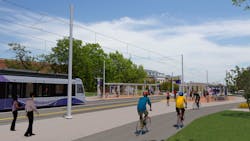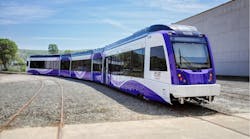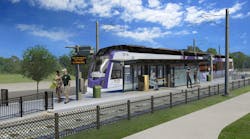MDOT MTA Purple Line won’t open until late 2026 and project costs have gone up too
It was safe to assume the Maryland Department of Transportation (MDOT) Maryland Transit Administration (MTA) Purple Line would not open in 2022 per its original schedule. However, a revised project schedule from state transportation officials shows the 16-mile line is estimated to open in the fall of 2026.
The project has experienced a contractor change, dealt with legal challenges and the impacts of the COVID-19 pandemic. With a new lead contractor on board and full scale construction expected to begin this spring, MDOT MTA and Purple Line Transit Partners (PLTP) continue to press forward with the project that will connect New Carrollton in Prince George’s County and Bethesda in Montgomery County, which are two of Maryland's most populace counties.
“Despite the challenges over the last several years, we have never lost sight of the benefits of the Purple Line for the residents and businesses in the National Capital Region. Taking the Purple Line P3 Agreement amendment to the Board of Public Works is the next step needed to move the Purple Line from construction into an active light rail line that creates a truly interconnected regional transit system. Getting to this critical step was made possible by the true partnership with Purple Line Transit Partners and the support of our county, state and federal partners to get this project built,” said MTA Administrator Holly Arnold.
In November 2021, MDOT MTA, with input from PLTP, selected Maryland Transit Solutions (MTS), comprised of Dragados USA Inc. and OHL USA Inc., to be the project’s design-build contractor. PLTP holds the public-private partnership agreement with MDOT MTA to design, build, finance and operate the light-rail project.
The original lead contracting team on the project pulled out in May 2020 citing delays and rising costs. A $250-million settlement was reached, a new lead contractor selected and, with the Maryland Board of Public Works approval of an amendment to the P3 Agreement that includes MTS’ involvement – possibly at its Jan. 26 meeting – full scale construction will commence on the project in the spring 2022. MDOT MTA mentions in the report that procurements of this size typically take 18 to 24 months to complete, but the design-build contract was accomplished in slightly more than one year.
Light-rail vehicle assembly is progressing on the 28 needed cars with eight of the cars ready for shipment, eight undergoing testing and eight being assembled.
One other piece of good news, the report says the entire light-rail line with 21 stations will open at the same time in 2026 rather than in phases.
Costs up 66 percent
The report also provided updated costs of the P3 Agreement, which have increased approximately 66 percent over 2016 numbers. In 2016, the P3 Agreement cost was $5.59 billion. Updated costs put the P3 Agreement at $9.28 billion – a $3.69 billion increase. The new design-build contract has increased $1.4 billion – 75 percent – from $1.97 billion in 2016 to $3.44 billion in 2022.
State officials cite “rising material costs across the industry, a smaller labor force, material shortages due to supply chain challenges, increases in the insurance market and other factors” for the steep increase in cost. The officials note the challenges impacting costs on the project are also being experienced on other major projects across the United States.
PLTP will finance the added cost through a combination of debt and equity that state officials say will be repaid through availability payments made by the state. PLTP will need to achieve operational and performance targets outlined in the P3 Agreement before it receives those availability payments.
Despite the delay in project delivery and rising costs, MDOT MTA says the P3 model and its financing components make expansion into “a critical region of the state” possible without incurring additional costs to operate outside of its core area of Baltimore.

Mischa Wanek-Libman | Group Editorial Director
Mischa Wanek-Libman is director of communications with Transdev North America. She has more than 20 years of experience working in the transportation industry covering construction projects, engineering challenges, transit and rail operations and best practices.
Wanek-Libman has held top editorial positions at freight rail and public transportation business-to-business publications including as editor-in-chief and editorial director of Mass Transit from 2018-2024. She has been recognized for editorial excellence through her individual work, as well as for collaborative content.
She is an active member of the American Public Transportation Association's Marketing and Communications Committee and served 14 years as a Board Observer on the National Railroad Construction and Maintenance Association (NRC) Board of Directors.
She is a graduate of Drake University in Des Moines, Iowa, where she earned a Bachelor of Arts degree in Journalism and Mass Communication.





